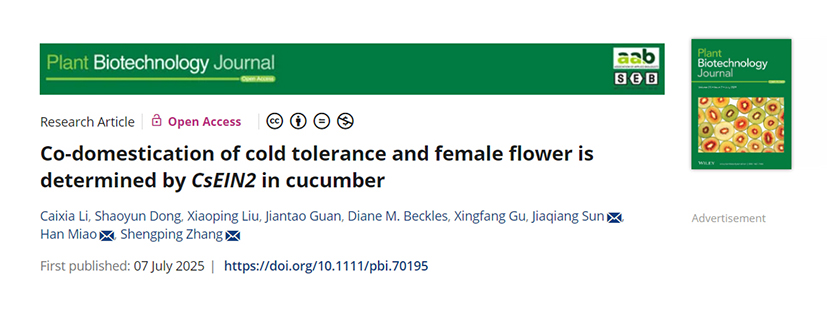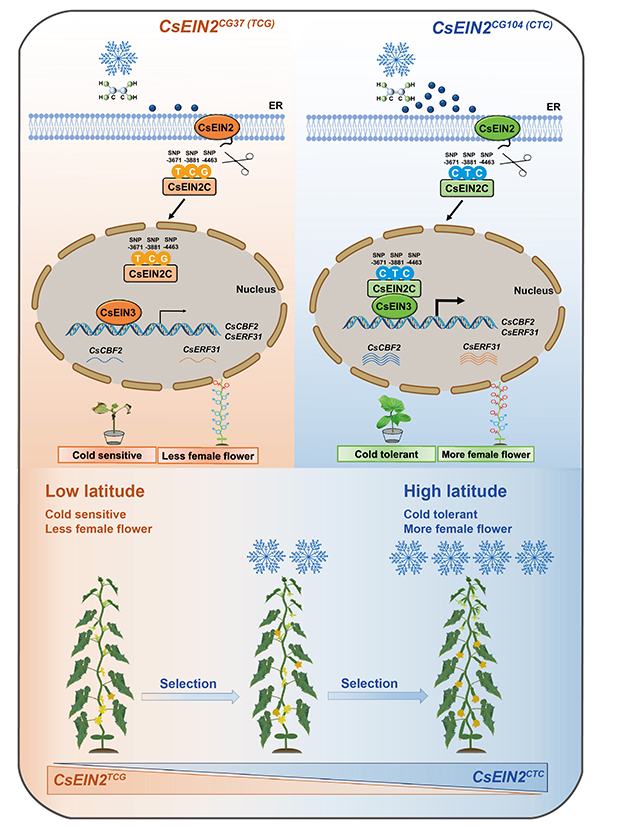Recently, Prof. Zhang Shengping’s team makes great progress on the molecular mechanisms of cucumber cold tolerance and female flower development. CsEIN2 acts as an indispensable hub gene in regulating both cold tolerance and female flower percentage (FFP) in cucumber. The critical functional sites were identified, which provides a valuable breeding framework for improving cucumber yield and adaptability. The research findings was published in《Plant Biotechnology Journal》(IF5 year = 12.4).

Global climate change causes significant losses in agriculture. Cold stress is a common adverse stress that affects plant growth and development; improving crop adaptability to cold stress is crucial for ensuring food security. Cucumber is an economically important vegetable crop valued for its nutritional profile and culinary versatility. Cucumber originated from India, a tropical region. Cold stress led to deleterious effects such as reduced growth and developmental processes, and they restrict the potential geographic and spatial distribution suitable for cultivation. Consequently, there is an urgent demand to elucidate the genetic determinants underpinning cold stress resilience in cucumber as a foundational step towards the genetic improvement of this trait in this economically vital crop.
We demonstrate that CsEIN2 acts as an indispensable hub in regulating both cold tolerance and FFP in cucumber. Specifically, we discover that three completely linked natural variations at the C-terminus of CsEIN2, that is, the CsEIN2CTC and CsEIN2TCG haplotypes determine the differences in cold tolerance and FFP. These variations affect the interaction of CsEIN2 with the transcription factor CsEIN3, which activates the expression of target genes such as CsCBF2 and CsERF31 to regulate cold tolerance and FFP, respectively. Interestingly, the geographical distribution analyses show that the CsEIN2CTC haplotype, conferring higher cold tolerance and FFP, underwent artificial selection for adaptation to environmental conditions in high-latitude regions. Further, we find that CsEIN2 is the only sex determination gene for selection of both cold tolerance and FFP. Collectively, our findings not only establish CsEIN2 as a ‘hub’ regulator that enhances cold tolerance and FFP, but also provides target gene for breeding.

Figure 1. A proposed working model for the co-domestication of cold tolerance and female flower development mediated by CsEIN2.
Postdoctoral Researcher Li Caixia, Associate Researcher Dong Shaoyun, Doctor Liu Xiaoping, Associate Researcher Guan Jiantao, from the State Key Laboratory of Vegetable Biobreeding at the Institute of Vegetables and Flowers, CAAS, are the co-first authors of the paper. Researcher Zhang Shengping, Researcher Miao Han and Researcher Sun Jiaqang are the co-corresponding authors. The research was supported by the Basic Research Center for Horticultural, the National Natural Science Foundation of China, the National Key Research and Development Program of China, the Earmarked Fund for Modern Agro-industry Technology Research System, the Agricultural Science and Technology Innovation Program of the Chinese Academy of Agricultural Sciences, State Key Laboratory of Vegetable Biobreeding, and the Key Laboratory of Biology and Genetic Improvement of Horticultural Crops, Ministry of Agriculture, P.R. China..
Link to this paper: https://onlinelibrary.wiley.com/doi/10.1111/pbi.70195